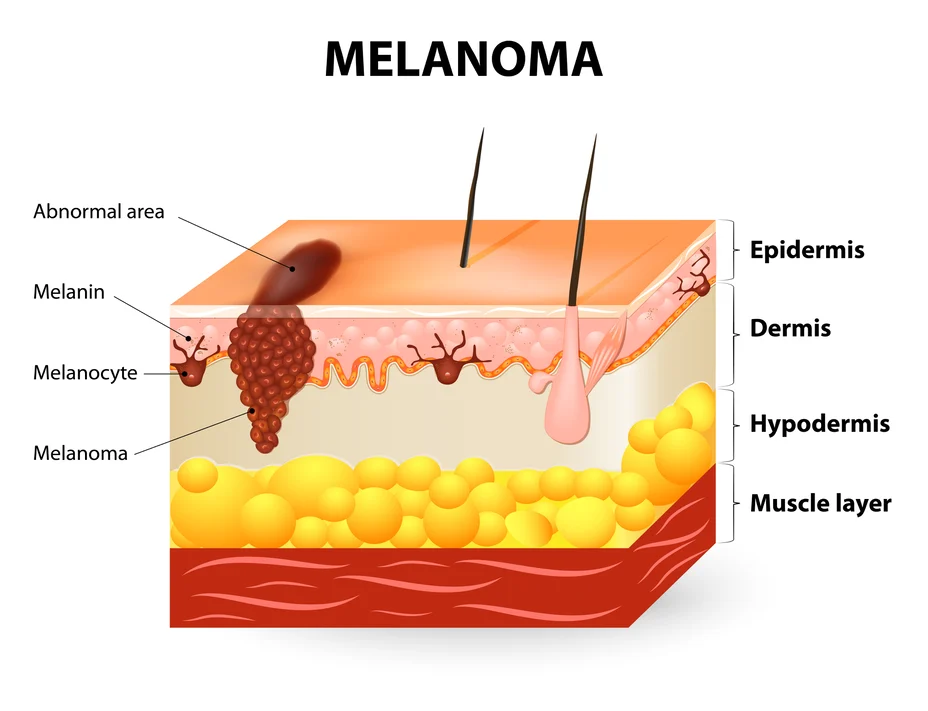Using sunscreen and taking protective measures to prevent skin cancer is usually only discussed in the summer months. Beginning in the spring, you see big displays of sunscreens at your local grocery store, serving as a reminder to stock up for the warm months ahead. But what about the cold winter months?
Using protective sun products in winter seems unnecessary, but it’s essential. Using SPF 15+ on a daily basis reduces the risk of melanoma by 50%. It also protects you from sunburn, which you can still get in winter, especially if you spend time outside in the snow.
The Skin Cancer Foundation reports that over the past 30 years, more people have had skin cancer than all other cancers combined. And that one in five Americans will develop skin cancer in the course of a lifetime. These statistics are alarming, but you can take action to drastically reduce your risk of skin cancer.
Read on to learn about the different types of skin cancer and the products you should be using to protect your skin.
WHAT IS SKIN CANCER?
Skin cancer occurs when the DNA in your skin cells is damaged, usually by ultraviolet radiation from the sun or tanning beds. When the DNA is unrepaired, it can trigger mutations that cause the skin cells to grow abnormally. The skin cells multiply quickly, which results in the formation of malignant tumors.
The most common types of pre-cancers and skin cancers are: actinic keratosis, atypical moles, basal cell carcinoma, squamous cell carcinoma, and melanoma.
Actinic Keratosis
Actinic keratosis is a growth caused by ultraviolet radiation. There is rarely just one growth, they appear in clusters with a crusty, rough appearance. They can look like warts and are typically red, although some are white, pink or tan. Actinic Keratosis is the most common pre-cancer, and can develop into squamous cell carcinoma if left untreated.
Actinic keratosis is commonly found on the back of the hands, forearms, face, ears, shoulders and neck. It can be hard to detect, as the growths are often small, making it crucial that you get regular skin checks by a board-certified dermatologist.
Atypical Moles
Atypical moles are not cancerous, but those who have them do have an increased risk of developing melanoma. The moles may be may resemble melanoma and tend to be more common in people who have family members with atypical moles.
If your dermatologist says you have atypical moles, you need to be especially cautious in the sun and keep a close eye on the moles. If the moles change at all, you need to let your dermatologist know.
Basal Cell Carcinoma
Basal cells are found in the deepest layer of your epidermis (outer layer of skin). When the cells are abnormal, they cause growths that have a range of appearances. The growths can look like open sores, smooth shiny bumps, scars or pink/red areas of skin.
Basal cell carcinoma is the most common form of skin cancer — but it rarely spreads throughout the body. If caught early, the prognosis is good, but it must be treated quickly.
Squamous Cell Carcinoma
Squamous cell carcinoma is the second most common form of skin cancer, affecting the squamous cells in the skin’s top layers. It’s essential that it is caught early, as the cancer can be disfiguring or even deadly.
The growths are usually raised from the surrounding skin and can look crusty. They may bleed and can sometimes look like open sores. Like other pre-cancers and cancers, they’re most common on areas of the body repeatedly exposed to the sun.
Melanoma

Melanoma causes the most deaths of any skin cancer, killing more than 10,000 people in the US every year. If it is caught early, patients have a very good outlook; however, it can spread to other parts of the body. It’s crucial to catch it before it spreads, which means frequent skin checks are necessary.
Melanoma can develop from existing moles or may look like a mole. They’re usually brown or black, but sometimes they are pink/red, blue, white or even the same color as the surrounding skin. The risk of melanoma is drastically increased with every sunburn you get — if you have had more than five sunburns, your risk of melanoma is doubled.
WHAT CAN I DO TO PROTECT MY SKIN? | SKIN CANCER PREVENTION
Protecting your skin from ultraviolet radiation is easy, but you have to be consistent. The ultraviolet radiation from the sun is the same in winter, even though it’s cold outside. This means that your preventive skin care routine needs to be year-round, not just during summer.
We put together a step-by-step guide to help you create a realistic plan to improve your skin health and reduce your risk of developing skin cancer.
- Stop using tanning beds. If you still use tanning beds, even infrequently, it’s vital that you stop. Those who use indoor tanning beds have a 67% increased risk of developing squamous cell carcinoma. And those who used tanning beds before they turned 35 have a 75% increased risk for melanoma.
- Use sunscreen or sunblock year-round. If you’re going to use a product every day, you need to like it. Find a product that doesn’t feel oily and has a scent that you like. If you enjoy using the product, applying it won’t feel like a chore. And don’t forget your lips — lip balms with SPF 30+ are also important for daily use.
Why should you use sunscreen or sunblock year-round (even on cloudy days)? Because the sun’s UV rays are just as strong in the winter months, and they penetrate the clouds. If there is snow on the ground, almost 80% of the UV radiation is reflected. In comparison, sand only reflects about 25% of UV radiation.
Read our full blog about the difference between sunblock and sunscreen here.
- Rethink your wardrobe. Wearing clothes that protect your skin from the sun such as long-sleeved tops and wide-brimmed hats can create a barrier between your skin and the sun. Sunglasses are also an essential accessory, as they keep the sun’s harmful rays out of your eyes (the sun can burn your eyes, too). Use this as an excuse for a shopping trip — you can make a fashion statement and keep your skin and eyes healthy.
- Start seeing a dermatologist for annual skin checks. Most people don’t start seeing a dermatologist until there is already a problem. It’s important to start seeing a dermatologist every year to have your skin checked for pre-cancers and skin cancers (among other skin conditions). The earlier you start this habit, the less likely you are to develop any type of skin cancer.
Remember, your dermatologist isn’t going to judge you if you’ve used tanning beds in the past or have used tanning oils when laying out in the sun. They want to help you develop a good preventive skin care routine that reduces your risk of pre-cancers and skin cancers.
If you would like more information about preventive skin care, download our guide below:
SKIN CANCER CHECK IN MORGANTOWN | DERMATOLOGY CENTER FOR SKIN HEALTH, PLLC
At the Dermatology Center for Skin Health, PLLC, our primary goal is to help our patients develop life-long skin care habits that keep them cancer-free. We develop positive relationships with our patients, making annual skin checks a comfortable experience.
Our doctors only stock the best skin care products, taking the guesswork out of your selection. When you buy your sunscreen and sunblock from us, you know you’re getting a top-quality product, safe and effective for daily use.



